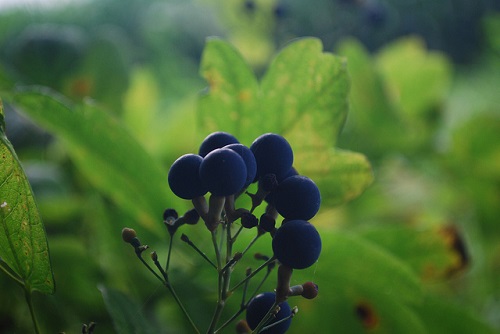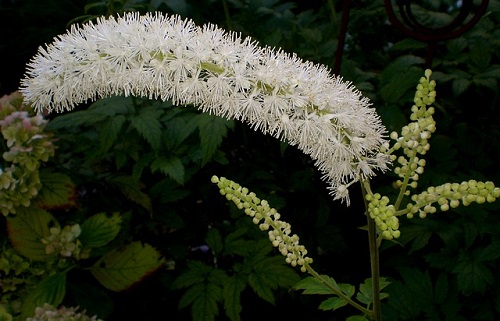Difference Between Blue Cohosh and Black Cohosh

Blue Cohosh berries (Caulophyllum thalictroides)
Blue Cohosh vs. Black Cohosh
If it is your first time encountering black cohosh and blue cohosh roots, you will probably have the impression that they come from the same subtype of plants, only with some variation in color, as the names would suggest. But despite their similar ‘cohosh’ names, they are actually two distinct roots. In fact, they do not even come from the same genus and family of plants. Moreover, both black and blue cohosh roots are considered medicinal herbs, used and introduced by Native Americans. They can address health problems and illnesses specific to women, such as those related to menstruation, pregnancy, and sexually transmitted infections.
Blue cohosh, scientifically called Cauloophyllum thalictroides, is a member of the berberidaceae, or barberry, group. It grows abundantly in North America, specifically in between the boundaries of Manitoba and Oklahoma. Black cohosh, also known as black snakeroot or fairy candle, belongs to the Ranunculaceae, or buttercup, family. Its scientific name is Cimicifuga racemosa. Like its counterpart, it can be found across North America. Both plants were discovered and utilized by Native Americans for medicinal purposes, even before English settlers occupied the continent.
Although they are both intended specifically for women, their functions and effects vary. Black cohosh is considered an anti-spasmodic. This means that it can ease cramps caused by pre-menstrual syndrome, hot flashes during menopause, and other effects of hormonal imbalance. It does this by inhibiting the secretion of luteinizing hormone (LH). It also evens out hormonal fluctuations by balancing estrogen production. Other ailments that can be addressed by this herb are kidney troubles, hypercholesterolemia, coughs, sore throat, and depression. Like black cohosh, blue cohosh is intended for treating conditions specifically related to hormonal imbalances. It can alleviate abdominal cramps and help in the treatment of cervical dysplasia, chlamydia, and endometriosis. Moreover, is regarded as a uterine tonic; this means that it is beneficial to the uterus, especially during pregnancy. In the case of abortion or miscarriage, blue cohosh can expedite the recovery of uterine tissues. Other than being a remedy, it is also an abortive herb. This is because of a contained substance called Caulosaponin that can induce uterus contractions.

Black Cohosh
Like most medicines, black and blue cohosh herbs have their corresponding side effects. Prolonged use of the former has been speculated to contribute to liver damage. Common downsides include weight fluctuation, low blood pressure, seizures, nausea, constipation, diarrhea, headaches, and slow heartbeats. On another note, it’s also not advisable to overuse blue cohosh because of the adverse effects it can cause, especially to the kidneys and the heart.
A combination of blue and black cohosh is effective in ripening the uterus, preparing it to release its content with minimal labor in delivery during childbirth. The same property can also disrupt pregnancy if taken during the early stages. Both herbs can be taken in standard decoction, tincture, powder, or capsule form. To prepare black cohosh decoction, its roots must be simmered for approximately 10 minutes. It is taken up to 4 times a day with a dosage of 1 to 4 tablespoons. Blue cohosh takes longer to simmer at an average time of 25 minutes. The dosage for blue cohosh is .5 to 1 cup consumed up to 4 times a day.
Summary
- Black and blue cohoshes are medicinal herbs that can address an array of female reproductive problems.
- Black cohosh, with its estrogenic anti-spasmodic properties, is effective in relieving menstrual cramps and other symptoms brought about by hormonal imbalances. Blue cohosh, on the other hand, specializes in ripening the uterus for easier labor during childbirth.
- A combination of black and blue cohoshes can also facilitate pregnancy abortion.
- Prolonged use of either herb may cause kidney, liver, and heart problems.
- Differences Between Fraternity And Sorority - January 8, 2014
- Differences Between Lucite and Plastic - January 7, 2014
- Differences Between Oil and Butter - January 6, 2014
Search DifferenceBetween.net :
2 Comments
Leave a Response
References :
[0]https://www.flickr.com/photos/wackybadger/6178195418
[1]https://pixabay.com/en/black-cohosh-garden-flower-autumn-969277/

Hi thanks for this information
Please where can I get blue cohosh root. I am in Nigeria.
Hi Favor! Please am also in Nigeria Ibadan precisely and I would like to if it has a local name